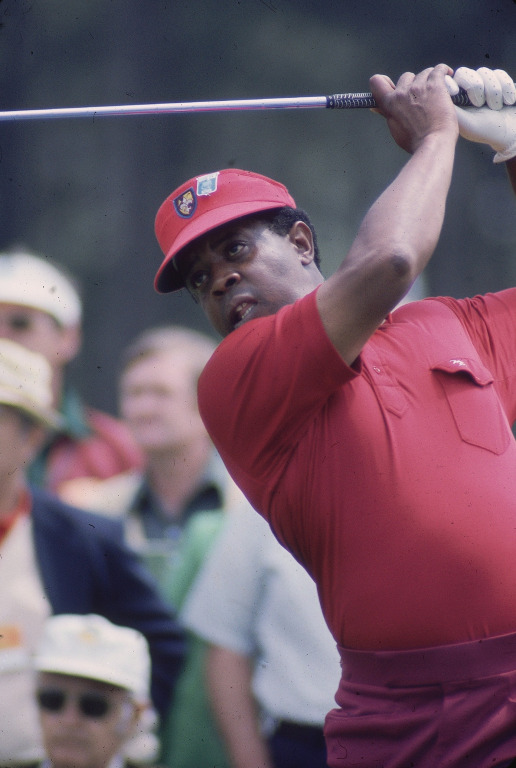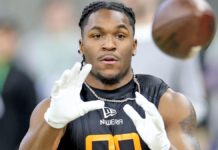Shortly before 8 a.m. on Thursday, Lee Elder will join Jack Nicklaus and Gary Player on the first tee of the Augusta National Golf Club as an honorary starter for the 85th Masters Tournament. Honorary starters have been a tradition at the Masters since 1963, but Elder will be the first African American to play this role at golf’s most prestigious event.
Elder’s first visit to this tee box came when he broke the color barrier at the 1975 Masters after years of fighting for his rights as a Black man to compete alongside the game’s elite. By then, Nicklaus, Player and Arnold Palmer had long been considered the Big Three — defining for a generation the rivalries and popularity of the game. For several years until Palmer’s death in 2016, this trio of Masters champions served together as honorary starters at the tournament.
The Big Three was the invention of IMG founder Mark McCormack, who saw it as a clever way of marketing his clients as the top three players in the world. Fred Corcoran, a legendary tournament promoter of the PGA Tour in the 1930s and ’40s, considered the trio the “third great cycle of golf.” The first great cycle, he said, had consisted of Bobby Jones, Walter Hagen and Gene Sarazen, and the second was Ben Hogan, Sam Snead and Byron Nelson.

Eric Schweikardt/Sports Illustrated via Getty Images
In the parallel world of the all-Black United Golfers Association (UGA), where the best Black players shined before the PGA’s Caucasians-only clause was struck down in 1961, Elder might have formed a big three with fellow Black golfers Charlie Sifford and Pete Brown. Before them, there were Ted Rhodes, Bill Spiller and Howard Wheeler. Had racism not kept these Black players off the PGA Tour in the prime of their careers, they might have formed their own triumvirates to shape a century of golf in America.
Since the Masters Tournament announced in November that it was making Elder an honorary starter, I have felt a certain ambivalence about the gesture that arose out of the upheaval in the summer of 2020 over the deaths of George Floyd and Breonna Taylor and many other African Americans at the hands of police. It’s worthwhile to honor Elder and to use the moment to call attention to racial disparities in our society and the game of golf. However, the whole notion of honorary starters is a fierce reminder of the Black golfers who did not have a chance because of their race to build reputations in the mainstream game to warrant this lofty perch. In other sports, I saw examples of Black athletes helping to shape the character and culture of the games. Wilt Chamberlain, Bill Russell and Oscar Robertson unintentionally fashioned a big three in the NBA. For baseball, Willie Mays and Hank Aaron formed a big three with Mickey Mantle.

Bettmann/Contributor
Like Elder, Aaron was born in 1934, the year of the first Masters, to a poor Black family in the Deep South. When Aaron died in January, 45 years after his retirement in 1976, he still held MLB records for RBIs (2,297) and total bases (6,856). For a better part of the ’50s and ’60s, Mays, Mantle and Aaron formed a trio of the most dominant sluggers during baseball’s golden era. Even as segregation ruled the South, Mantle appeared on baseball cards with Mays or Aaron signifying the trio’s stature in the game. While we may remember most how Aaron endured death threats during his chase of Babe Ruth’s home run record, it’s also important to know that Aaron made his major league debut as a 20-year-old in 1954 and was able to amass record-setting statistics over a 23-year career.
When they were both in the prime of their careers, Elder toiled on the UGA circuit for $500 purses while Aaron blossomed into one of the most recognizable names in sports. In one stretch in the early ’60s, Elder won 21 of 23 events on the UGA circuit, a dominant record by any standard. Yet he’s most discussed for breaking the racial barrier at the Masters and less for a playing career that included four PGA Tour wins, eight Senior PGA Tour Champions titles and a Ryder Cup appearance in 1979.
In Aaron’s New York Times obituary, his career was compared with those of Mays and Mantle because they were the big three who helped define the game for a generation of baseball fans that transcended race. For legions of adults and kids, they were to baseball what Palmer, Nicklaus and Player were to golf in the formative years of televised sports. With these three octogenarian men at Augusta — Elder, Nicklaus and Player — we have players of a generation who harken memories of segregation and racism. The same racist systems that made Elder’s pilgrimage to Augusta very rocky are the same systems that made the passages for Nicklaus and Player a lot smoother. These two white men are no less important than Elder to understanding the powerful racial symbolism of this moment in Masters history.
The Augusta National Golf Club and Masters tournaments can’t erase their pasts of keeping Black people in largely servile roles and out of the tournament field. … But what the PGA Tour can do is recognize the records of Elder, Sifford, Rhodes and so many other pioneering Black players as a part of its official record.
Nicklaus was raised in Upper Arlington, Ohio, an affluent white suburb of Columbus. One of the earliest settlers of Upper Arlington was Pleasant Litchford, a freed slave who migrated from Lynchburg, Virginia, to the area with his family around 1832. Litchford became a successful blacksmith and one of the largest landowners in the settlement with 227 acres. He was active in the anti-slavery movement and allowed his property to be used in the Underground Railroad. He donated land to build a school for Black children. Litchford died at 89 years old in 1879 with his obituary notice in the Daily Ohio State Journal describing him as a man of “iron constitution.” In his will, Litchford designated a half-acre of land for a family cemetery that would also be the final resting place for his family and friends, including his 11 children and their many offspring.
In the early 1950s, the city of Upper Arlington bought a large tract of land that was once owned by Litchford to build a new Upper Arlington high school. During construction of the school in 1955, workers found the half-acre Litchford Cemetery underneath what would become the science wing of the school, a portion of the parking lot and a sports field. The school district moved 10 bodies to another cemetery in town. In 2017, an archaeological team returned to the site and found one fully intact grave with a complete set of remains, two partially exhumed graves and three fully exhumed graves. A planned new high school will include a memorial to the gravesites.

Two years after the Litchford Cemetery was first discovered, Nicklaus graduated from this new Upper Arlington High in an all-white senior class. This was not by accident. In 1970, an Upper Arlington homeowners association was forced to disband by court order for restricting African Americans from buying homes in the suburb for more than 20 years. Owners were forbidden from selling, leasing or renting “to a person or persons of any race other than Caucasian.”
In both the 2016 and 2020 presidential elections, Nicklaus was a vocal supporter of Donald Trump, who along with his father, Fred Trump, faced charges from the civil rights division of the U.S. Justice Department for discriminatory housing practices in the 1970s. “In my opinion, [Trump] has been more diverse than any president I have seen and has tried to help people from all walks of life — equally,” Nicklaus said on his social media a few days before the election.
On Jan. 6, Trump supporters attacked the U.S. Capitol, where a joint session of Congress was voting to formalize the election of Joe Biden as the next president. Yet in the same endorsement of Trump before the election, Nicklaus asked voters to look past the president’s words. “You might not like the way our president says or tweets some things … but I have learned to look past that and focus on what he’s tried to accomplish.” Less than a week after the attack on the Capitol, the PGA of America terminated the agreement to play the 2022 PGA Championship at Trump National Golf Club Bedminster in New Jersey.

PGA of America via Getty Images
One person who did not change his plans with the president was Player, who accepted the Presidential Medal of Freedom, along with LPGA Hall of Famer Annika Sorenstam, in a private White House ceremony on the day after the Capitol riots. “This is the greatest honor that I have ever been bestowed to me in my 70 years of playing golf around the world,” Player said during the ceremony.
Player had gone through an evolution with his political beliefs from early in his career when he made apologies for South Africa’s apartheid regime to challenging the system principally through his role as an international golfer. In America, he was the focus of the anti-apartheid protesters during tournaments. During the 1969 PGA Championship at the NCR Country Club in Kettering, Ohio, protesters threw ice and telephone books at him and shouted obscenities in the middle of his shots. Player was in the group with Nicklaus when a protester charged them on the green. Nicklaus kept the protester at a distance by threatening to hit him with his putter. “I wasn’t bitter about it,” Player told Golf.com. “I mean, our country practiced the most terrible system, as America did.”
Player had become synonymous with apartheid to Americans and, for many years before South African Black activist Nelson Mandela was released from prison in 1990 after 27 years, the golfer born in Johannesburg in 1935 was the most visible South African athlete in the world. Four years before Elder first entered the field at the Masters, Player invited him to play in two tournaments in South Africa in 1971. Player convinced South Africa’s prime minister, John Vorster, to allow Elder to play in the events at a time with apartheid laws placed severe limitations on the mobility and freedoms of the country’s Black people.
Each of us is born into stories that we didn’t start. The question isn’t so much about whether Nicklaus and Player are racists or what responsibility they have for racial inequities in their communities. But Litchford is as much Nicklaus’ story as it is mine or Elder’s. The Black cemetery underneath his alma mater is rooted in the systematic uprooting of Black bodies and families for centuries that made his life possible. Player and Nicklaus cannot claim on the one hand to profess great admiration and respect for Elder, and on the other hand support leaders and policies that would challenge his fundamental place in society.
In 1994, Nicklaus was asked by a reporter why there were so few Black golfers in the professional ranks. By then, dozens of African Americans had played on the PGA Tour. Nicklaus had famously beaten Elder in a five-hole playoff in the 1968 American Golf Classic in Akron, Ohio. But still he could say, “Blacks have different muscles that react in different ways.” The 18-time major champion later tried to qualify his statements.
“I said the kids today are gravitating to the sports that best fit their body and the environment where they’re growing up,” he told Sports Illustrated. “The white society to a large degree is becoming nonfunctional. Whites are spending time in cars, they’re sitting behind desks, they’re not out exercising, whereas the young Black kid is in an environment where he’s exercising.
“His muscles develop and they develop to the degree of that type of sport. I think the opportunity is there for young Black kids to play golf, just like the opportunity is there for young white kids to play basketball. But I don’t think they’re gravitating to the same level.”
Nicklaus can’t erase these statements or the historic roots of his hometown. The Augusta National Golf Club and Masters tournaments can’t erase their pasts of keeping Black people in largely menial roles and out of the tournament field. The club can’t award Elder a winning record at the Masters to rival the other honorary starters. But what the PGA Tour can do is recognize the records of Elder, Sifford, Rhodes and so many other pioneering Black players as a part of its official record. In December, MLB announced that it would include the statistics and records of the Negro Leagues as a part of MLB history. If Elder’s UGA wins were included as a part of his PGA Tour record, he would have a great case for inclusion into the World Golf Hall of Fame alongside his fellow honorary starters.
When Elder steps on the first tee at Augusta National on Thursday morning, it will mark the 47th anniversary of Aaron hitting his 715th home run to break Ruth’s record. “A Black man is getting a standing ovation in the Deep South for breaking a record of an all-time baseball idol,” Dodgers broadcaster Vin Scully said on his call from Atlanta Fulton County Stadium on April 8, 1974. “And it is a great moment for all of us, and particularly for Henry Aaron.”
Almost exactly a year later, Elder arrived on the first tee for his first Masters to “polite applause.” This time around he will get Hammerin’ Hank’s standing ovation in the Deep South, not for any records he set, but for his role in changing the game — an achievement worth a place at the table with any big three in the sport’s history.







